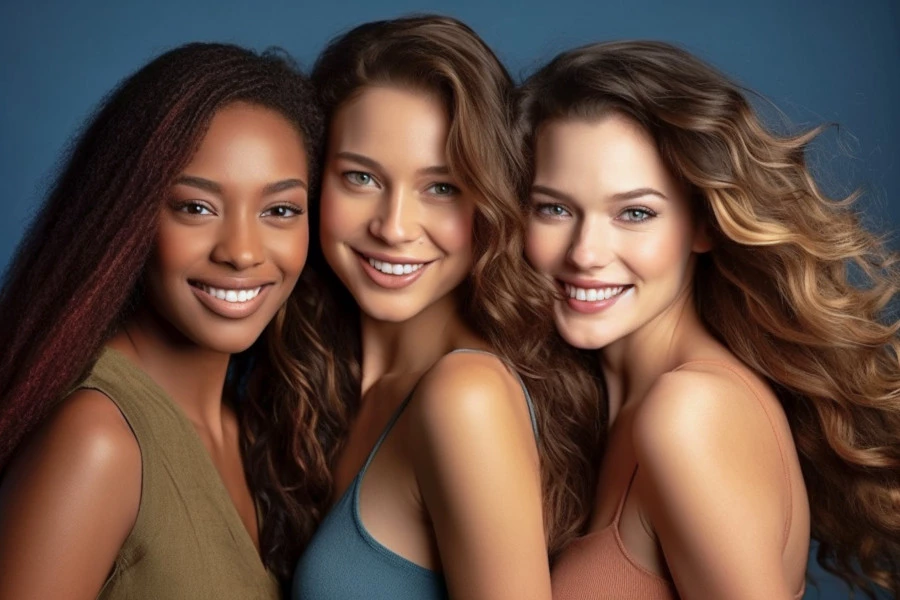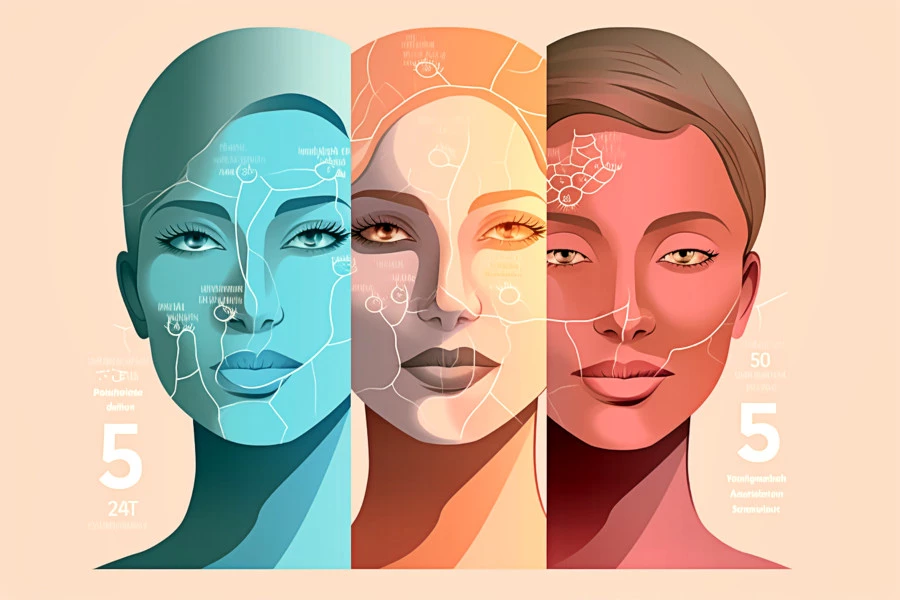In a world of over seven billion unique faces, the variety of skin tones and undertones we see is nothing short of a masterpiece of human diversity. Our skin is like a canvas, where nature has painted a beautiful portrait using hues ranging from light to dark, and shades from cool to warm.
Each one of us, undeniably unique, contributes a splash of color to the broad and vibrant spectrum of human skin tones. This in-depth guide is a celebration of diversity, an exploration of the science that creates our skin tones, and a guide to understanding, caring for, and enhancing your individual hue.
Join us on this exciting journey, as we delve into the fascinating world of skin tones and undertones, embracing the kaleidoscope of colors that make us who we are.
Here are the main topics we’ll dive into today:
Understanding Skin Tones and Undertones
Color, so omnipresent, so diverse, plays a pivotal role in defining our perception of the world around us. And when it comes to human skin, this palette of hues is nothing short of a grand tapestry, showcasing the breathtaking diversity of our species.

Our skin tells a fascinating story of our heritage, ancestry, and our body’s unique response to external stimuli. Beneath its surface lies a complex system that determines the tones and undertones we see on the outside.
Let’s dive into the science of skin:
- The Role of Melanin in Determining Skin Tones
- The Spectrum of Skin Tones: From Light to Dark
- Beyond the Surface: The Mystery of Skin Undertones
The Role of Melanin in Determining Skin Tones
Melanin, produced by cells called melanocytes, is the primary determinant of skin color. The more melanin you have, the darker your skin tone. It’s like nature’s sunscreen, protecting your skin from harmful UV rays.
But melanin does more than just protect your skin from the sun. It creates the rich canvas upon which the story of our skin is written, impacting not just our color but our identity, heritage, and perception in society.
Read more: Different Types of Skin Colors: Ultimate Guide
The Spectrum of Skin Tones: From Light to Dark
Skin tones run a remarkable spectrum, from porcelain light to rich dark, reflecting the diverse genetic heritage of the human race. But it’s not a binary scale; it’s a gradient, an ever-transitioning range of hues that captures the dynamism of human diversity.
Each of the skin tones tells a story, of geographic ancestry, of adaptation to sun exposure, and of a shared human journey.
Beyond the Surface: The Mystery of Skin Undertones
If skin tone is the visible palette, the undertone is the hidden canvas that influences how those colors appear. Skin undertones—warm, cool, or neutral—add depth and dimension to your skin color.
Skin undertones affect how certain colors look on you, how you should choose makeup, and even what jewelry suits you best. Much like an unseen thread, they subtly weave through your skin, influencing its overall hue.
Exploring Different Skin Tones and Undertones
Skin color, a fascinating symphony of genetics, biology, and evolution, is much more than meets the eye. As we embark on this journey of exploring skin tones and undertones, let’s remind ourselves that each shade, each undertone is unique, beautiful, and worthy of celebration.

With a spectrum that spans the globe, human skin tones and undertones form a beautiful tapestry of diversity. To understand your own skin better, it’s important to learn about the various categories and classifications:
- Warm, Cool, and Neutral Skin Undertones
- Olive to Asian: the Rich Tapestry of Skin Tones
- African Skin Tones: A Study in Diversity
Warm, Cool, and Neutral Skin Undertones
Warm undertones are rich with yellows, peaches, and golds, emanating a sun-kissed radiance. Cool undertones, in contrast, have hints of blues, pinks, or reds, casting a rosy elegance. Meanwhile, neutral undertones are the balanced intermediates, a harmonious blend of both warm and cool hues. Each undertone paints a distinct aura around your skin tone, influencing its vibrancy and mood.
Olive to Asian: the Rich Tapestry of Skin Tones
Olive skin, marked by a slight greenish tint, often possesses neutral or warm undertones, while Asian skin can range from light to dark with various undertones. They each bear unique characteristics in pigmentation, sun reaction, and skin aging, all of which influence the skincare and makeup choices that would best enhance their natural beauty.
African Skin Tones: A Study in Diversity
African skin tones are an enchanting array of deep hues, showcasing an array of undertones from cool blues to warm reds. With high melanin content, they possess a unique beauty but also face distinct skincare concerns such as hyperpigmentation.
Read more: Melanin-Rich Skin Care: How To Nourish And Protect Dark Skin
Determining Your Skin Tone and Undertone
Identifying your skin tone and undertone is a valuable step in perfecting your skincare routine and enhancing your makeup skills. It allows you to select products that truly complement your skin, leading to a more harmonious and natural look:
Steps to Uncover Your Skin Tone
Determining your skin tone isn’t a quest for the Holy Grail. Start with natural light, which doesn’t distort colors like artificial lighting can. Next, examine your skin in a mirror, preferably a clean, large one that provides a clear view. Focus not just on your face but also on your chest and arms, which might be a different shade. Remember, the goal isn’t to classify yourself strictly but to understand your unique color palette.
Finding Your Skin Undertone
To decipher your undertone, perform this simple test: observe the veins on the inside of your wrist. If they appear blue or purple, you likely have cool undertones. Greenish veins usually indicate warm undertones. If it’s hard to tell whether your veins are more blue or green, you may have neutral undertones. While this test isn’t foolproof, it’s a good starting point.
Confirming Your Findings: A Self-Test
For a final confirmation, hold a white and cream cloth (one at a time) next to your face while looking in the mirror. The white will enhance cool undertones, making your skin seem to glow, while the cream will do the same for warm undertones. If both look equally flattering, you likely have a neutral undertone.
Factors Influencing Your Skin Tone and Undertone
Multiple elements come into play when it comes to the color of our skin. Some are deeply rooted in our genetics, while others are shaped by our environment and lifestyle:
- How Your Heritage Influences Your Skin
- Age and Sun Exposure: External Factors at Play
- Understanding Hyperpigmentation and Discoloration
How Your Heritage Influences Your Skin
Our skin tones and undertones are a tapestry woven from our genetic heritage, with each ancestor contributing a thread to the complex pattern. This genetic influence explains why people of similar geographic or ethnic backgrounds often share similar skin characteristics.
Age and Sun Exposure: External Factors at Play
Over time, factors like aging and sun exposure can affect your skin tone, causing it to darken or develop spots. Sun exposure, in particular, can temporarily darken your skin tone and provoke freckles or age spots. Always remember to protect your skin when exposed to the sun for extended periods.
Understanding Hyperpigmentation and Discoloration
Hyperpigmentation, an increase in melanin that causes skin to darken, can affect your perceived skin tone. It often appears as spots or patches and can result from factors like acne, injuries, hormonal changes, or certain medications. Dealing with these concerns with proper skincare can help maintain a balanced and even skin tone.
Skin Tone, Undertone and Nutrition
Your skin is a reflection of your overall health, and that includes your diet.

Certain nutrients are particularly beneficial for skin health. Vitamins A, C, and E, for instance, have antioxidant properties that help protect the skin from damage. Meanwhile, Omega-3 fatty acids can help keep the skin moisturized and supple.
And while it’s beyond the scope of this guide to delve into specifics, it’s essential to maintain a balanced diet full of fruits, vegetables, lean proteins, and whole grains to keep your skin healthy and radiant.
Customizing Your Skincare Routine: Products for Different Skin Tones and Undertones
Just as everyone’s skin tone is unique, so too should be their skincare routine. There are products available tailored to different skin tones, helping to address specific issues and enhance natural beauty:
- Skin Toners: Balancing Your Skin’s pH
- Tinted Moisturizers, BB Creams and CC Creams
- Products to Enhance Lighter Skin Tones
- Products to Celebrate Darker Skin Tones
- Solutions for Uneven Skin Tones
Skin Toners: Balancing Your Skin’s pH
Skin toners play a pivotal role in balancing your skin’s pH levels, offering a harmonious environment where your skin thrives and feels genuinely happy. In the intricate dance of skincare, toners sweep in after cleansing, correcting the pH and prepping the skin for the ensuing hydration and nourishment steps.
Thanks to innovation in the skincare industry, toners are really evolving, giving rise to products like toning cleansers and toning essences:
- Toning cleansers simplify your regimen by merging the cleansing and toning steps, providing a hassle-free experience without skimping on benefits.
- Toning essences are like skincare unicorns, offering the dual magic of hydration and toning in one sleek package, blessing your skin with moisture while maintaining that crucial pH balance.
With these innovative products on the shelf, maintaining a balanced skin pH has never been more effortless or more delightful!
Read more: Skin Toning & Tightening: 6 Healthy Habits for Radiant Skin
Tinted Moisturizers, BB Creams and CC Creams
Choosing the right tinted moisturizers, BB creams, or CC creams begins with understanding your skin tone and undertone. Generally, this means going for a shade that matches your skin tone closely.
Those with warm undertones should opt for products with yellow or peachy hues, while those with cool undertones should look for products with pink or blue hues. Neutral undertones provide a bit more flexibility, as both warm and cool shades can work well.
Products to Enhance Lighter Skin Tones
Lighter skin tones can be susceptible to redness and irritation, so products with soothing ingredients like chamomile or aloe can be beneficial. Also, look for products with SPF to protect from sun damage, which can be more visible on lighter skin.
Products to Celebrate Darker Skin Tones
Darker skin tones can benefit from products that address issues like hyperpigmentation or uneven skin tone. Ingredients like Vitamin C and niacinamide can help even out the skin tone and enhance the natural glow of darker skin. Moisturizing is also crucial as darker skin can often appear ashy when dry.
Solutions for Uneven Skin Tones
For those struggling with uneven skin tones, look for products that can help brighten and even out your skin. Ingredients like retinol, Vitamin C, and hydroquinone are often recommended. However, it’s crucial to use these products as directed and always protect your skin from the sun, as they can increase photosensitivity.
Read more: Toxin-Free Skincare: Clean Ingredients & Natural Products
Makeup Mastery: Enhancing Your Skin Tone and Undertone With Cosmetics
The world of makeup is a playground where you can highlight, contour, and play with color to enhance your natural skin tone and undertone. The first step to creating a flawless canvas is choosing the right foundation:
- The Right Foundation: A Guide for Every Skin Tone
- Makeup Tips for Warm, Cool, and Neutral Skin Tones
- Makeup Tricks for Olive, Asian, and African Skin Tones
The Right Foundation: A Guide for Every Skin Tone
Finding the perfect foundation match is paramount for creating a seamless, natural look. Warm undertones should gravitate towards foundations with yellow, peachy, or golden hues. Cool undertones work best with pink, red, or blue-based foundations. For neutral undertones, look for a balanced mix that doesn’t lean too heavily on either side. When testing foundation shades, apply a small amount on your jawline to see how it blends with both your face and neck.
Makeup Tips for Warm, Cool, and Neutral Skin Tones
The colors you use in your makeup can highlight your skin tone and undertone. Warm skin tones glow with earthy shades like peach, yellow, gold, and brown. Cool tones are complemented by jewel tones, rosy pinks, silvery blues, and plum hues. Neutral tones have the flexibility to experiment with a wide color range but generally shine with soft pinks, browns, and some jewel tones.
Makeup Tricks for Olive, Asian, and African Skin Tones
For olive skin tones, lean on warm, earthy colors for your eyes and lips, while a hint of gold can enhance your natural radiance. Asian skin tones can be quite diverse, but generally, vibrant shades like coral, berry, and rose gold work beautifully. African skin tones look stunning with rich, deep hues like berry, copper, and bronze.
Celebrate Your Unique Skin Tones and Undertones!
Understanding your skin tone and undertone is more than just a pathway to enhancing your beauty—it’s a journey of self-discovery and self-celebration. As you explore the wide range of skincare and makeup products available, remember that there is no one-size-fits-all solution. Your unique skin deserves personalized care. So, here’s to celebrating your individual beauty and to many days of glowing, healthy skin!

We’ve journeyed together through the compelling narrative of skin tones and undertones, unearthing the science, exploring the global palette, and discovering ways to enhance our natural beauty. But, this journey isn’t just about aesthetics. It’s about self-discovery, appreciation, and most importantly, celebration. Your skin, with its unique tone and undertone, tells a story – a tale of your genetic heritage, the environmental factors you’ve encountered, and the journey you’ve taken throughout your life. It’s a tale that is uniquely yours, and it’s beautiful.
Read more: Building an Effective Personalized Skincare Routine
Embrace your skin tone – care for it, enhance it, and wear it with pride. After all, in the art gallery of humanity, you are your own masterpiece. Remember, every skin tone is beautiful, and every undertone adds depth to that beauty. The world wouldn’t be as colorful, vibrant, or beautiful without you exactly as you are.
Let’s continue to celebrate the stunning diversity of human skin tones and undertones. After all, our differences don’t just make us unique—they make us beautiful.
Frequently Asked Questions
We understand that the journey to discover and celebrate your unique skin tone can bring up a series of questions. Here, we address some of the most common queries we’ve encountered in our exploration of skin tones and undertones:
- How can I improve my skin’s texture and even out my complexion?
- What skincare ingredients are good for my skin tone?
- What are some natural remedies for achieving even skin tone?
- What types of makeup products can help even out skin tone?
- Does my diet affect my skin tone?
- Can my skin undertone change over time?
- Is it possible to have more than one skin undertone?
- What skincare routine is best for my skin tone?
- What factors should I consider when choosing a sunscreen?
How can I improve my skin’s texture and even out my complexion?
By maintaining a consistent skincare routine that includes cleansing, exfoliating, moisturizing, and protecting your skin from the sun, you can enhance your skin’s texture and tone. Products containing ingredients like retinol, Vitamin C, and niacinamide can be particularly beneficial for skin texture and tone.
What skincare ingredients are good for my skin tone?
While skin tone doesn’t usually dictate the types of skincare ingredients you should use, certain issues associated with specific skin tones may benefit from targeted ingredients. For example, Vitamin C and niacinamide can help address hyperpigmentation often seen in darker skin tones.
What are some natural remedies for achieving even skin tone?
Natural remedies for even skin tone include using ingredients like turmeric, honey, aloe vera, and lemon juice. However, remember that results from natural remedies can vary, and it’s essential to patch test any new ingredient on a small part of your skin to check for any adverse reactions.
What types of makeup products can help even out skin tone?
Foundations, concealers, BB creams or CC creams can help even out skin tone. Look for products that offer good coverage but still blend seamlessly with your natural skin tone and undertone.
Does my diet affect my skin tone?
Indeed, your diet can have a significant impact on your skin tone. Foods rich in antioxidants such as fruits, vegetables, nuts, and seeds can promote a healthy glow. Similarly, foods containing carotenoids (like carrots, pumpkins, and tomatoes) can slightly change your skin tone over time. Hydrating foods and drinking plenty of water can also help maintain the elasticity and health of your skin. However, changes will be subtle and won’t drastically alter your natural skin tone.
Can my skin undertone change over time?
Your skin undertone is generally determined by genetics and remains consistent throughout your life. However, the overtone or the skin color you see on the surface can change due to factors like sun exposure, skin conditions, or aging. It’s important to note that while your undertone remains the same, changes in overtone might influence the colors that suit you best.
Is it possible to have more than one skin undertone?
It’s generally accepted that most people fall into one of three undertone categories: cool, warm, or neutral. However, skin is complex and doesn’t always fit neatly into these categories. Some people might find they have characteristics of two categories, usually referred to as neutral-cool or neutral-warm.
What skincare routine is best for my skin tone?
Skincare is less about skin tone and more about skin type. However, certain skin tones can be more prone to specific issues. For example, lighter skin tones may be more prone to sunburn and sun damage, so a good SPF is vital. Darker skin tones may be more prone to hyperpigmentation, so products that brighten and even out skin tone can be beneficial. It’s always recommended to consult a dermatologist or skincare professional to create the most effective routine for your skin.
What factors should I consider when choosing a sunscreen?
When choosing a sunscreen, it’s important to consider both your skin type and tone. Those with lighter skin tones might burn more easily and thus require a sunscreen with a higher SPF. On the other hand, individuals with darker skin tones might prefer sunscreens that won’t leave a white cast. Regardless of skin tone, choosing a broad-spectrum sunscreen that protects against both UVA and UVB rays is essential for everyone.